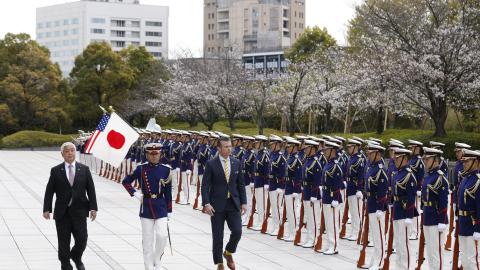Peter Rough testifies before the House Committee on Foreign Affairs.
Written Transcript
Chairmen Bera and Keating, Ranking Members Chabot and Fitzpatrick, distinguished members of the Subcommittees, thank you for the opportunity to appear before you today.
The Case for Europe
We are gathered six months to the day that Joe Biden took the oath of office as the 46th president of the United States. Half a year into his presidency, the contours of America’s foreign policy under our new president are coming into focus.
In his first consultations with foreign leaders after winning the presidency, then President-elect
Biden telephoned the heads of government in Ireland, the United Kingdom, France, and Germany. Last month, in his first and only trip abroad to date, the president traveled to Europe for summits of the G7, the European Union (EU), and the North Atlantic Treaty Organization (NATO) before meeting with Russian president Vladimir Putin in Geneva.
It is no exaggeration to say, therefore, that the U.S. is sailing into the Pacific Century with a longstanding Atlanticist at the rudder. Confronted by a changing order, the president has reverted to type, seeking to navigate our policy challenges, including the overarching issue of China, through Europe.
At first blush, such an approach makes a good deal of sense. There are three, and really only three, major power centers in the world today: East Asia, North America, and Europe. To draw an imperfect, yet nonetheless instructive parallel to the Cold War, Kissingerian triangulation teaches that the U.S. should seek to mobilize Europe to its side in the competition with China. In that endeavor, given longstanding ties, the U.S. enjoys a big head start.
But China is running a more modest race. It aims to merely neutralize, or Finlandize, Europe with respect to the issues it deems essential to its interest. If the U.S. is seeking to forge a transatlantic front in order to sustain a favorable balance of power, Beijing aims only to split the United States from its allies in the belief that it can subsequently exert its will in a series of bilateral contests.
In sum, China’s goal is to turn America’s European allies into a Switzerland-on-steroids: economically relevant yet politically unaligned. As Henry Kissinger himself put it in 2018, such a scenario would turn Europe into “an appendage of Eurasia” at the mercy of China. It should surprise no one, therefore, that Chinese officials enthusiastically support the ambition, most closely associated with Emmanuel Macron, the French president, of “European strategic autonomy” from the United States.
The Sino-European Relationship
The Biden administration has taken office at a time of flux in Sino-European relations. In the past few years, a paradox has developed: Europe and China have grown closer in the economic realm yet drifted apart in political terms.
The convergence of China and Europe can be explained by economics. For the past five years running, China has been the largest trading partner of Germany, the economic engine of Europe. In fact, more than 5,200 German companies have established operations in China.
This dependency is especially noteworthy in politically sensitive sectors. Volkswagen, for example, is the most important company in the most important industry of Europe’s most important economy, and the majority of its sales are now in China. Beyond Germany, other crown jewels of the European economy, from British financial services to Italian and French luxury brand makers, are deeply embedded in the Chinese market.
China has supplemented its status as a growing consumer market with promises of foreign direct investment (FDI) into Europe. This FDI is part and parcel of its broader Belt and Road Initiative (BRI), which stretches from China across Eurasia with its terminus in the German city of Duisburg. In 2016, the Chinese shipping firm Cosco acquired the Athenian port of Piraeus, which Xi promised to turn into Europe’s largest facility during a visit three years later. That same year, Italy became the first G7 country to join the BRI.
China has sought to convert these economic moves into political gains, in part through the socalled “plus 1” format of central and eastern European states. Under current plans, for example, the port of Piraeus is to ship goods over a rail-line China has proposed from Belgrade to Budapest. It is no coincidence that China counts Greece, Serbia, and Hungary amongst its most reliable supporters in Europe today.
And yet, China’s reputation in Europe has taken a blow of late. Its political ties with the continent are fraying. In 2017, Xi gave a major address at the CCP’s 19th Congress in which he jettisoned China’s decades-old mantra of “hide your capacities, bide your time” and announced a “new era” in which China would take “center stage.” This decision may prove one of the great strategic blunders of our time. The aggressive posture that has flowed from Xi’s guidance has awoken the United States to the perils of Chinese dominance and forced Europe to reconsider its relationship with Beijing.
In particular, Europeans who have dared to highlight Chinese human rights violations or balked at Huawei’s inclusion in their 5G networks have been threatened with reduced access to the Chinese market. The continent has watched with growing trepidation as Beijing has strangled key Australian exports merely because Canberra called for an independent investigation into the origins of COVD-19.
China’s ruthlessness has only reinforced the point. The world has discovered China’s genocide against the Uighurs and witnessed the end of Hong Kong’s autonomy. Unsurprisingly, Beijing has also shown total contempt for international law, breaking the Sino-British Joint Declaration of 1984 and ignoring the Permanent Court of Arbitration’s rulings on the South China Sea.
This overreach has had an effect. In May, Chinese reprisals to a series of European sanctions over the genocide in Xinjiang led the European parliament to freeze ratification of the just negotiated Comprehensive Agreement on Investment (CAI). That same month, China’s lackluster investments in eastern and central Europe culminated in Lithuania’s departure from the “17 plus 1” – now “16 plus 1” – format. To make matters worse for China, the plight of tiny Montenegro, saddled with an unsustainable BRI debt, has captured headlines from Brussels to Washington. Even Germany is now debating its China policy in anticipation of Angela Merkel departure from the chancellery later this year.
At the very moment that European exporters are relying on Chinese markets to jumpstart their economic recovery, relations with Beijing have worsened.
The U.S. Strategy
The Biden administration entered office with the intention of building “interlocking and overlapping coalitions” of European allies against China. In particular, it has launched a charm offensive in Berlin and Brussels in the hopes of enticing a German-led Europe into action.
Although this approach has engendered goodwill, it’s unclear if it will produce results. In judging its policy, the U.S. must guard against the temptation to conflate process with substance and harmony with progress.
To be sure, the NATO, G7, and U.S.-EU summit communiqués all included significant paragraphs touching on China, the latter two referencing Taiwan. But beyond the rhetoric, the strongest military action Europe could take to support Taiwan and deter China is to increase its own defense capabilities. If the U.S. military is to focus more of its attention on the Indo-Pacific, it will need more capable allies to support it in the defense of the European continent.
In that vein, Antony Blinken’s ruminations during his maiden voyage to Brussels as secretary of state in March on “the need to adopt a more holistic view of burden-sharing” that includes development assistance carries the risk of arresting recent progress. Under present plans, for example, it will take Germany longer to fulfill its obligation to spend 2 percent of GDP on defense than it took for it to fight the First and Second World Wars combined.
It must remain the priority of the U.S. government to insist that all NATO member states meet their own defense spending pledges, including the Wales goals. As a general matter, the U.S. should continue to embrace the concept of specific benchmarking as a tool for modernizing and strengthening the alliance. It is far easier to convince, even cajole, member states when they are measured by mutually agreed upon commitments rather than ambiguously crafted statements.
Moreover, the U.S. should welcome the increased attention the United Kingdom and France have given the Indo-Pacific in their own strategies. The UK is reinforcing its so-called “tilt” toward the region by deploying the HMS Queen Elizabeth East of Suez while France has undertaken Freedom of Navigation Operations in the South China Sea. Germany, too, is deploying the Bayern into the Pacific this year, although the frigate’s port call in Shanghai is representative of its more cautious approach.
Of course, European militaries must first and foremost secure the North Atlantic region. Even Europe’s largest militaries do not have the capabilities to assume the role of a global power. But these deployments to the Indo-Pacific help forge a common transatlantic strategic approach toward Asia. To assist in that process, the Biden administration should encourage regular exchanges, partnerships, and exercises between Europeans and our frontline allies in Asia, especially Australia and Japan.
The true test of transatlantic solidarity will come in another domain, however: geoeconomics. During his March trip to Europe, Secretary Blinken assured our allies that the U.S. will not present them with an “us or them” choice on China. In fact, just the opposite is true: any U.S.EU strategy worthy of implementation will generate blowback from China. When that pressure arrives, we should expect more from our treaty allies than studied neutrality. The choice they face is not simply between the United States and China, but between a free and open order and a Sino-centric hierarchy of vassals.
The CCP’s economic model is fundamentally predatory. Its plan to dominate the high-tech industries of the future, first dubbed “Made in China 2025,” relies on theft and coercion on an unprecedented scale, as well as the targeted acquisition of foreign technologies. It also depends on the West overlooking China’s use of subsidies and protectionism to establish competitive advantages. By the centennial of the People’s Republic of China’s founding in 2049, the CCP plans to showcase autarky, not interconnectedness, with Europe taking the place of the consumer, rather than producer, of high-end products. The CCP’s Military-Civilian Fusion program is running the same playbook to transform the People’s Liberation Army into the world’s leading military force.
Six months into the Biden administration, policymaking in this crucial area remains a work in progress. The U.S. and EU inaugurated a Trade and Technology Council (TTC) at their most recent summit to tackle these challenges, but time is of the essence. In recent weeks, for example, Chinese attempts to take full control of the UK’s largest chip foundry nearly passed without so much as a review.
Two of the most urgent priorities for the TTC are investment screening and export controls. The EU-wide investment screening mechanism established in 2019 was announced to much fanfare but is a far cry from the American CFIUS. As a result, the U.S. should build on the progress of national governments, such as Germany’s adoption of new standards after the Chinese takeover of its prized robotics firm, Kuka, in 2017. The challenges of investment screening are only growing larger with the advent of ever more complex shell companies and ambiguous partnerships. The rapid advance of new technologies is also straining traditional conceptions of dual-use items, forcing the U.S. and Europe to demonstrate extra vigilance in monitoring acquisitions. To ease the burden, the U.S. should share CFIUS best-practices and broaden its intelligence sharing on Chinese behavior. The Biden administration should also leverage the work of the Clean Network Alliance, which represents some 60 countries that constitute the majority of the world’s GDP.
A defensive strategy alone will not be sufficient, however. The U.S. must offer alternatives to Chinese investments. The Biden administration should seize on the Three Seas Initiative (TSI) as an opportunity to curtail Russian and Chinese influence in eastern Europe. To avoid duplication, TSI should be closely coordinated with the European Commission.
Like investment screening, Europe’s export control regime lags that of the United States. The U.S. has had some notable successes in persuading European allies to prevent the export of key technologies, however. Since 2019, for example, the Dutch government at the urging of the United States has denied ASML licensing to supply China with the lithography equipment necessary for advanced chip fabrication.
Recently, Congress has considered supplementing the Wassenaar Arrangement on Export Controls, which relies on voluntary notifications and includes Russia, with a more robust mechanism for transatlantic allies. Crucially, such a body would include veto powers for its members, modeled after the Cold War-era Coordinating Committee for Multilateral Export Controls (COCOM).
While I would welcome such a step, the CCP would not take it lying down. It has already signaled its intention to fight back with whatever leverage it can accrue. “We should increase the dependence of international supply chains on China,” Xi instructed his officials last year, “and establish powerful retaliatory and menacing capabilities against foreign powers that would try to cut supplies.”
For the West to stand its ground against such inevitable pressure, it will need to get itself in order first. The lodestar of U.S. strategy should be to build as large and open an economic alternative to China as possible. For starters, the Biden administration must improve its performance in Europe beyond the capitals of Brussels and Berlin.
In recent years, the U.S. has made strides on Europe’s periphery through intensive commercial diplomacy. Now, those regions fear neglect, as the Polish foreign minister’s recent protestations suggest. Meanwhile, talks for a U.S.-UK FTA have stalled as the U.S. instead focuses on pressuring London on its dispute with the EU over the status of Northern Ireland. The first step in building a broad zone of free and democratic states as an alternative to China begins with forging a more cohesive and united Europe.
At the same time, the U.S. will also need to find common ground with Europe on regulatory and trade disputes, especially relating to the digital economy. A replacement for Privacy Shield that respects American national security requirements is most urgently needed. This is not just an issue impacting the world’s biggest tech giants, but the more than 5,300 American companies that relied on it to transfer personal data from the EU to the U.S. In 2019, digital-enabled services exports and imports to Europe reached over $245 billion and $133 billion, respectively. So long as a negotiated solution for transatlantic data flows remains elusive, U.S. businesses face high levels of uncertainty.
Of course, it is impossible to remove all irritants in the transatlantic relationship, especially on issues like trade and technology. But that should not forestall cooperation on major questions of international order. The U.S. and Europe should join forces in multilateral organizations to block China’s takeover of key bodies, just as it did at the World Intellectual Property Organization last year.
Moreover, the U.S. and Europe should recognize that China, too, is building partnerships around the world. It is as foolish to grant China’s principal partner in the Middle East, Iran, largescale sanctions relief as it is mistaken to allow China’s closest ally, Russia, to construct an energy pipeline that threatens the very integrity of Europe. In taking decisions related to Iran and Russia, the U.S. should always remember that both countries represent pathways for advancing Chinese power.
Time and again, when the U.S. has approached Europe with the right strategy, it has succeeded in harnessing that power to some benefit. But when the U.S. and Europe have proven at crosspurposes, the effect has been cancellation, undermining the objectives of both parties. The Biden administration’s strategic inclination to work with Europe is welcome, but now is the time to turn rhetoric into results.

















